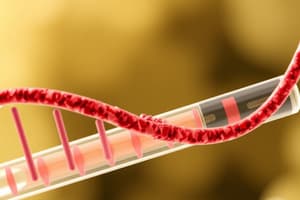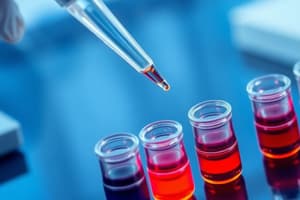Podcast
Questions and Answers
Which type of PCR is specifically designed to analyze multiple targets simultaneously?
Which type of PCR is specifically designed to analyze multiple targets simultaneously?
- Nested PCR
- Inverse PCR
- Multiplex PCR (correct)
- Reverse transcriptase PCR
Reverse transcriptase PCR (RT-PCR) involves the direct amplification of mRNA.
Reverse transcriptase PCR (RT-PCR) involves the direct amplification of mRNA.
False (B)
What is the purpose of the first reaction in Nested PCR?
What is the purpose of the first reaction in Nested PCR?
To produce a DNA product that serves as the template for the second reaction.
PCR can be used for prenatal diagnosis, such as amplifying DNA from a single __________ cell.
PCR can be used for prenatal diagnosis, such as amplifying DNA from a single __________ cell.
Match the following PCR types with their descriptions:
Match the following PCR types with their descriptions:
What is the main application of Reverse transcriptase PCR (RT-PCR)?
What is the main application of Reverse transcriptase PCR (RT-PCR)?
Amplification Fragment Length Polymorphism (AFLP) is a method that identifies viral sequences.
Amplification Fragment Length Polymorphism (AFLP) is a method that identifies viral sequences.
Name one application of Nested PCR.
Name one application of Nested PCR.
PCR techniques can amplify and examine DNA from ancient remains like __________ and genomes of extinct species.
PCR techniques can amplify and examine DNA from ancient remains like __________ and genomes of extinct species.
In which type of PCR do you splice two gene elements together?
In which type of PCR do you splice two gene elements together?
What is the function of agarose in gel electrophoresis?
What is the function of agarose in gel electrophoresis?
DNA fragments in gel electrophoresis move toward the negative electrode.
DNA fragments in gel electrophoresis move toward the negative electrode.
What are oligonucleotide primers essential for in the context of PCR?
What are oligonucleotide primers essential for in the context of PCR?
The migration of DNA molecules during electrophoresis is inversely proportional to the logarithm of their _____ length.
The migration of DNA molecules during electrophoresis is inversely proportional to the logarithm of their _____ length.
Match the following electrophoresis components with their purpose:
Match the following electrophoresis components with their purpose:
Which factor affects the specificity of the primers in PCR?
Which factor affects the specificity of the primers in PCR?
Large DNA fragments migrate faster than smaller fragments through the agarose gel.
Large DNA fragments migrate faster than smaller fragments through the agarose gel.
What are TBE and TAE buffers used for in gel electrophoresis?
What are TBE and TAE buffers used for in gel electrophoresis?
The process of applying an electric current to move DNA through the gel is called _____ electrophoresis.
The process of applying an electric current to move DNA through the gel is called _____ electrophoresis.
What length are oligonucleotide primers typically designed to be?
What length are oligonucleotide primers typically designed to be?
What is the ideal GC content percentage for primers?
What is the ideal GC content percentage for primers?
Primers can have complementary regions without affecting PCR yield.
Primers can have complementary regions without affecting PCR yield.
What is the melting temperature (Tm) range required for primers?
What is the melting temperature (Tm) range required for primers?
Primers should be _____ to _____ bp in length.
Primers should be _____ to _____ bp in length.
Match the following primer properties with their requirements:
Match the following primer properties with their requirements:
What happens if the annealing temperature (Ta) is too low?
What happens if the annealing temperature (Ta) is too low?
Hairpins are formed due to interstrand complementarity.
Hairpins are formed due to interstrand complementarity.
Name one online tool used for primer design.
Name one online tool used for primer design.
The formula for Tm calculation for primers shorter than 18 bases is Tm = 2(A + T) + 4(G + C). For longer primers, it is Tm = 64.9 + 41(G + C - 16.4)/(A + T + G + C). Here, A, T, G, and C represent _____ in the primer.
The formula for Tm calculation for primers shorter than 18 bases is Tm = 2(A + T) + 4(G + C). For longer primers, it is Tm = 64.9 + 41(G + C - 16.4)/(A + T + G + C). Here, A, T, G, and C represent _____ in the primer.
Why should runs of 3 or more Cs or Gs at the 3' ends be avoided?
Why should runs of 3 or more Cs or Gs at the 3' ends be avoided?
Flashcards are hidden until you start studying
Study Notes
PCR Variations
- Multiplex PCR: Amplifies various DNA targets simultaneously in a single reaction.
- Nested PCR: A two-step process, using two sets of primers for increased specificity. First, PCR amplifies target DNA, which then acts as the template for a second PCR, using primers nested within the initial amplification region.
- Inverse PCR: Identifies unknown sequences using known regions. Often used for analyzing transposons or retroviruses, which integrate randomly into DNA.
- Reverse Transcriptase PCR (RT-PCR): Measures gene expression by converting mRNA into cDNA using reverse transcriptase and amplifying it using PCR.
- Overlap Extension PCR: Combines multiple PCR products to create larger DNA fragments. Used for cloning large sequences and joining gene elements for research applications.
- Amplification Fragment Length Polymorphism (AFLP): Highly sensitive technique selectively amplifying restriction fragments from digested DNA, utilized for microsatellite analysis.
Uses of PCR
- Forensic Investigations: Identifying individuals using trace DNA samples.
- Evolutionary Research: Amplifying and analyzing DNA from ancient remains, including fossils, to trace evolutionary relationships.
- Prenatal Diagnosis: Amplifying DNA from single embryonic cells for pre-natal diagnosis.
- Disease Diagnosis: Detecting infectious agents such as HIV or COVID-19.
- Basic Research: Investigating gene structure and genomes.
Analyzing PCR Products
- Agarose Gel Electrophoresis: Separates DNA fragments based on size, using an electric current to migrate DNA through an agarose gel matrix. Larger fragments move slower than smaller fragments.
Primer Design
- Oligonucleotide Primers: Short, single-stranded DNA sequences, synthesized chemically, used to initiate PCR amplification.
- Primer Length: Typically 18-30 nucleotides long, influencing specificity and annealing efficiency. Short primers lack specificity leading to non-specific amplification, while long primers have reduced efficiency and higher chances of secondary structure formation.
- Primer Composition: Primers should not bind each other (Interstrand complementarity) to avoid non-specific binding. GC content should be between 40-60% for optimal annealing.
- Melting Temperature (Tm): Determines the temperature at which 50% of the primer hybridizes to its complementary sequence. Factors include primer length and base composition.
- Annealing Temperature(Ta): Temperature at which primers bind to target DNA. Ta is set 5 degrees Celsius below the lowest Tm of the primer pair. Choosing the correct Ta prevents non-specific amplification.
- Primer Properties:
- Length: 18-30 nucleotides
- GC content: 40-60%
- Tm: 45-70 degrees Celsius
- Ends in G or C or GC: Increases priming efficiency
- No complementary regions: Avoids non-specific binding
- Primer Design Tools: Available online tools like PrimerBlast and Primer3web aid in primer design.
- Universal Primers: Designed to bind to a variety of DNA templates, facilitating the amplification of a wider range of sequences.
Studying That Suits You
Use AI to generate personalized quizzes and flashcards to suit your learning preferences.




